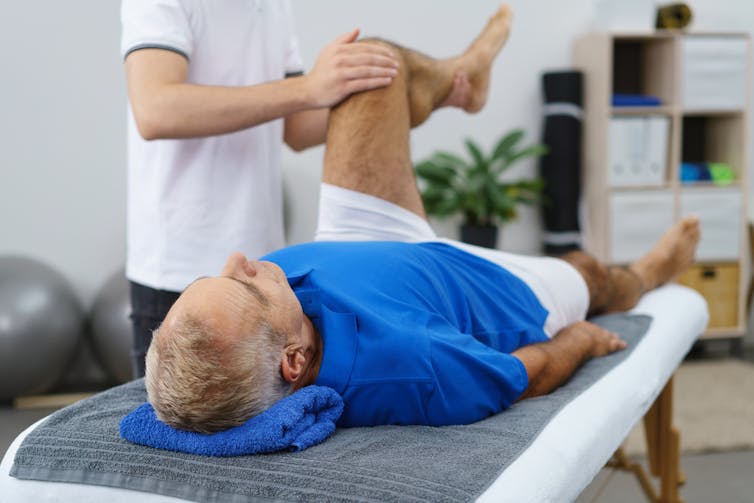Most private patients are wasting money on costly rehab after major knee surgery
- Written by Justine Naylor, Associate Professor, South Western Sydney Clinical School, UNSW
Most private patients who have had knee replacement surgery recover just as well with a cheaper form of rehabilitation than many are currently offered, research published today in the Medical Journal of Australia shows.
We found people who have had uncomplicated total knee arthroplasty recover just as fast and with similar outcomes after out-patient rehab – which involves people leaving hospital and having regular visits to a physiotherapist – rather than the costly in-patient option, where patients stay in hospital for their rehab.
Not only could most private patients avoid up to two weeks in hospital, they could save themselves or their insurers several thousands of dollars.
Read more: Confused about your private health insurance coverage? You’re not alone
What is knee arthroplasty?
Knee arthroplasty is major surgery, involving complex anaesthesia, removing the diseased knee joint and inserting artificial joint parts. Patients take a long time to recover; knee pain and swelling, and even muscle weakness, last for many months afterwards.
It’s a very common procedure. There’s a one in five chance of women having the procedure at some point in their lives; for men, that’s one in seven. The main reasons people have the surgery include severe knee pain or an unstable knee, mostly due to age-related osteoarthritis.
Over 50,000 knee arthroplasty surgeries are performed in Australia each year, with over two-thirds in the private sector.
Read more: Surgery isn’t always the best option, and the decision shouldn’t just lie with the doctor
The number of procedures is rising because more people have age-related osteoarthritis, partly because we are living longer and partly because we are becoming more overweight, which puts more pressure on the knees.
The surgery also seems to be safer than it used to be, including for elderly people. So, anecdotally, people are opting to have the surgery now where before they may have thought it too risky.
What rehab options are there?
Rehab options after knee surgery can vary depending on whether you’re a public or private patient.
In the public system, in-patient rehab is generally reserved for patients who are too frail to go home, who have no support at home, or have had complications after surgery. Most public patients attend rehab as an out-patient.
But in-patient rehab is more common for private patients, whose surgeon may offer it as an option.
 Physiotherapy is the main form of rehab after knee replacement surgery.
from www.shutterstock.com
Physiotherapy is the main form of rehab after knee replacement surgery.
from www.shutterstock.com
While physiotherapy is the mainstay of formal rehab for both public and private patients, those who attend as an in-patient can also see other health professionals like rehab physicians, occupational therapists and nurses.
Private patients who choose in-patient rehab after knee surgery typically stay in hospital for 7-14 days. This adds another A$9,500 or so to the median A$22,000 bill for the surgery itself. By comparison, we found rehab as an out-patient costs just a median A$374.
Which is better value for money?
To find out which option gave private patients the best outcomes, we conducted a national study involving privately insured people who had undergone uncomplicated total knee arthroplasty. We then compared the outcomes between people who had in-patient therapy with those who went straight home.
People with significant complications following surgery, who progressed slowly in the early days after surgery, and people with limited help at home, were excluded from our study.
To ensure we compared apples with apples, we matched people who went to in-patient rehab with those who did not on many characteristics including age, gender, body-mass index (a measure of obesity), and the severity of disease before surgery.
We phoned people 35, 90 and 365 days after surgery and asked for details about their recovery and the types of rehabilitation they had.
Read more: INFOGRAPHIC: A snapshot of private health insurance in Australia
People who received in-patient therapy reported similar knee-joint pain, and similar function and quality of life. Patients and their carers also took the same time off work regardless of the rehab option.
Median rehab costs for those who had in-patient therapy (A$9,978) were also much higher than costs for those who did not (A$374). The higher costs were due to the in-patient component, but, interestingly, also slightly more community-based therapy.
The main implication of our study is, given the cost difference between rehabilitation options, community-based (non-inpatient) alternatives seem to be better value.
What do we make of all this?
Our findings support our earlier trial published this year, as well as one by a Canadian team published almost ten years ago.
Together, these studies suggest community-based rehab is better value for patients without complications, regardless of whether they are public or private patients.
We acknowledge that patients who receive in-patient rehab are generally very satisfied with it; they enjoy the convenience of the “one stop shop” and it may provide respite for carers.
However, we also know patients who go home are also satisfied; many surgeons and physiotherapists also rate community-based therapy very highly.
The challenge for researchers, health-care providers, governments, patients and policymakers is to encourage the uptake of community-based therapies where appropriate so that in-patient rehab is reserved for those most in need.
If private sector rehab costs are kept in check, there is less pressure on health insurance premiums to rise. Hopefully, this in turn, encourages people to stay insured.
How do I choose what’s best for me?
To choose the best rehab option for you, here are three questions to ask your surgeon before your operation:
1) How do I know if I need in-patient rehab?
2) If I choose in-patient rehab, will I recover more quickly or better?
3) What are my rehab options other than as an in-patient?
Authors: Justine Naylor, Associate Professor, South Western Sydney Clinical School, UNSW




